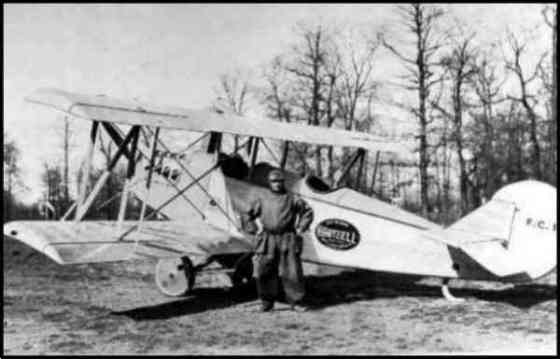INTERNATIONAL AIR MEET
ST. LOUIS, MO, 1923

St. Louis, Oct 12, 1923
| HARTZELL FC-1 INTERNATIONAL AIR MEET ST. LOUIS, MO, 1923 |
||
 |
||
| Walter & his Hartzell FC-1, Dayton, Oct. 2-3-4, 1923 St. Louis, Oct 12, 1923 |
PIQUA WINS FAME WITH VICTORY OF CHARAVAY'S AIRPLANE AT ST. LOUIS Ship Constructed at Hartzell Propeller Co., Here and Piloted by Walter E. Lees Captures First Place in Great Trophy Race Thursday Afternoon Piqua and Ohio were put forcibly on the aviation map in the Pulitzer races at St. Louis, Thursday afternoon, when the plane of Frederick Charavay, of Piqua, built at the plant of the George W. Hartzell company, and piloted by Walter E. Lees, of Dayton, won the Flying Club of St. Louis trophy race. The winner's average times in miles per hour for the 150-kilometer course (93.21 miles) was 89.31 While it was expected that the Charavay plane, which was designed by Mr. Charavay and built entirely in Piqua, would make a good showing, the clean cut victory against a large field of picked entrants from all over the United States was a pleasant surprise to practically everyone in Piqua who awaited news of the race with intense interest. While the commercial plane was entered through the Johnson Airplane and Supply company, of Dayton, it was built at the Hartzell company plant here, many new parts and designs being credited to Mr. Charavay.While not one iota of credit must be taken from the skillfull manipulation of the "air bird" by Lees, a veteran army aviator of Dayton, the fact is Charavay and the Hartzell company should come in for the major share of the honor of the victory. Lees himself, on landing, said that credit for the feat should go to Charavay. Generally, the Charavay plane was not conceded much of a chance at St. Louis just before the race started. The only support was from the "home folks" of Dayton and Piqua. However, when the Charavay ship passed the first three planes in front of it on the first lap and when it attained the highest average speed for the first trip, the onlookers began to notice it skimming through the air in wonderful style. SEPTEMBER 27, 1923 Three Contestants Arrive in City in On-to-St. Louis Race Air Board Receives Telegrams from Other Pilots Speeding Toward Bridgeton Field from Four Corners of Continent The first event of the International Air Races---the On-to-St. Louis race---is literally on. Three contenstants in this event finished their part of the race yesterday, and and the St. Louis Air Board has received telegrams from other pilots who are speeding towards St. Louis Fiedl from the four corners of the continent. Lawrence B. Sperry, flying a three-cylinder 60 horsepower Sperry Messenger, completed his remarkable dash from Farmingdale, New York, early yesterday morning anda the gathering dusk in the evening brought with it two other contestants, one from Okmulgee, Okl., and the other from Dayton, Ohio. The lasts two flights were made in one day. W. A. Burke took off from the local field at Okmulgee in his Laird biplane at 12:53 p. m. yesterday. He arrived at the field at 4:45 o'clock. His ship is powered by a 150 horse-power Hispano-Suisa engine. Walter E. Lees, flying a Hartzell FC-1, left Dayton, Ohio, at 11:25 a. m. yesterday, arriving in St. Louis Field at 5:45 o'clock. He made one stop in Indianopolis. ST LOUIS, THURSDAY, OCTOBER 4, 1923 Lees Wins First Race, Averages 89 Miles Hour Victor, Flying Hartzell FC1, covers 93.21 mile Course to Win Cup and $500 Offered by St. Louis Flying Club "Casey" Jones Takes Second Place---Local Aviator Finishes Fourth One Withdraws. Walter E. Lees, veteran air pilot, flying a Hartzell FC1, today won the Flying Club of St. Louis Trophy Race, in the initial contest of the International Air Races at Bridgeton. Twenty thousand persons witnessed the finish. Lees averaged 89.31 miles an hour for the 1250 kilometers (93.21 miles) three times around the course. He wins permanent possession of the trophy and $500 cash prize awarded the winner. "Casey" Jones, in a Curtiss Oriole, won second place. Jones' time was 86.77 miles an hour for the three circuits of the course. Second prize was $300. Perry Hutton, in an Laird Swallow, finished third with an average speed of 85.28 miles an hour. Hutton's prize for third place was $200. Robertson finished fourth. The trailers were Tex Lagrone and E. P. Hewitt. The two delayed entrants withdrew. They were E. T. Allen of Washington and Jack ("Red") Bartow of Houston, Tex. Lawrence B. Sperry suffered the only accident and made a forced landing between Seeberger, the location of pylon No. 3, and the finish line. He repaired his engine and took the air again, but finished last. He was in second place at the finish of the second lap. Lees is the only pilot in the race who built and designed his own plane, even to the propeller. He is one of the oldest pilots in the country. He was one of the aviators who taught Gen. Mitchell of the army air service to fly, in 1914. His machine, a Hartzell FC1, has a Curtiss OX5 engine, and was entered by the Johnson Aircraft Company. His machine has a horsepower of 98.5 Walter E. Lees, of Dayton, Ohio, son of Mrs. Richard Lees of this place, won the Flying Club of St. Louis, Mo., trophy at St. Louis, last week Thursday. The winner's average time in miles for the 93.21 miles course was 89.31. The plane driven by Lees, a Hartzell FC-1, was entered by the Johnson Airplane and Supply Co., with whom he is employed. Walter has been in the flying game the past fifteen years. During the war, he was in the government service as an instructor. His friends here are pleased to learn of his victorious flight. The plane was in the class listed as ninety-horse power or under. 

|